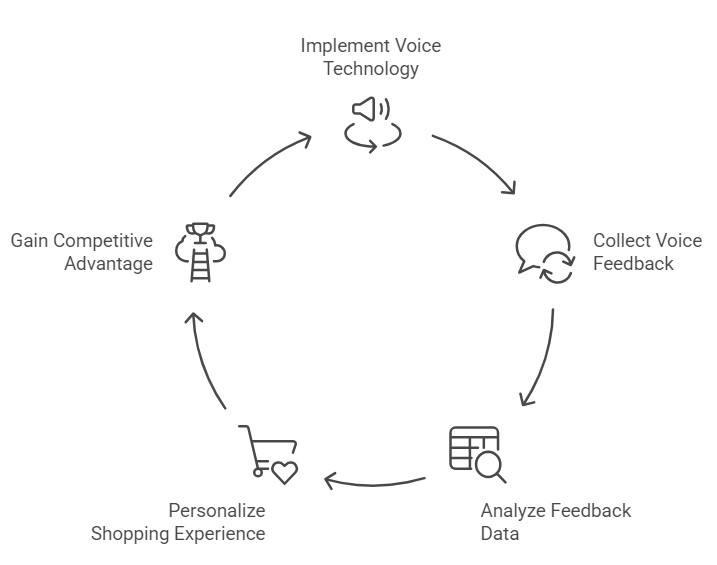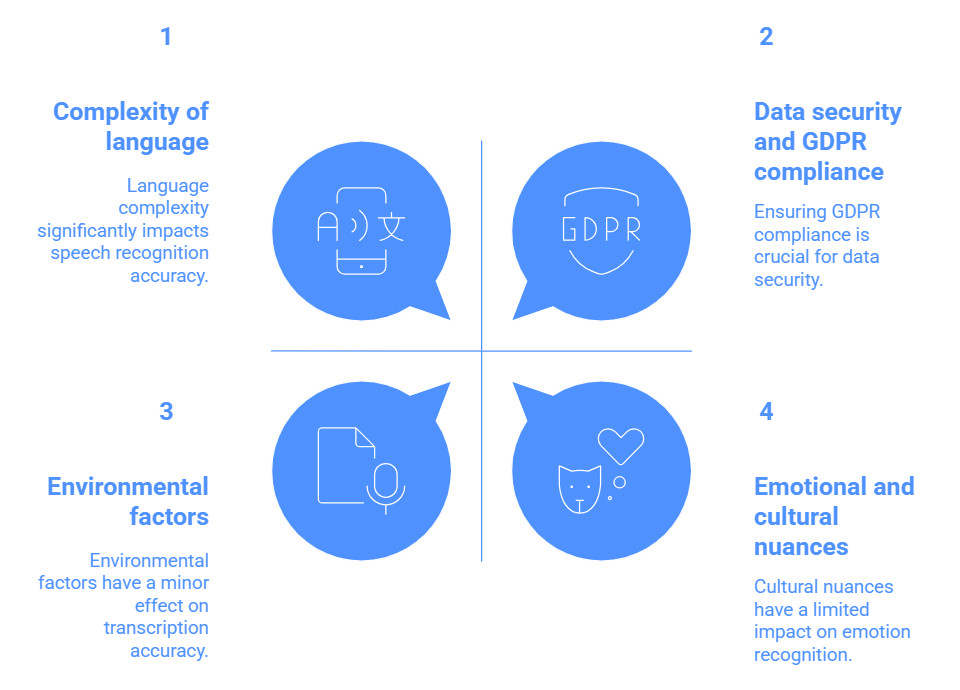- Research platform
Sources of information
Data analysis
Actions
- Solutions
For whom
Problems / Issues
- Materials
Materials
- About us
About us

Have you wondered why your customers are reluctant to complete traditional surveys? The answer is simpler than you think. Today's (especially young) consumer expects quick, intuitive solutions, and writing reviews on a small smartphone screen can be a frustrating experience.
Voice feedback and speech analytics in e-commerce are revolutionizing the way feedback is collected. Recent industry studies have consistently shown that voice feedback can increase the number of reviews received by 300% compared to traditional online forms. This is an opportunity to gain a deeper understanding of customer expectations and gain a competitive advantage.
With this article, you will learn how voice technologies are transforming the process of collecting feedback, what business benefits they offer and how to implement them in your online store. Get ready to discover tools that open up new opportunities in analyzing user behavior and personalizing the shopping experience of today's consumer.
Voice feedback in e-commerce is an innovative approach to collecting and analyzing customer feedback, using audio recordings instead of traditional text. Classic reviews and forms, often filled out on small smartphone screens, can be frustrating and discourage customer engagement, leading to short, superficial responses.
Voice feedback eliminates these barriers. It allows customers to express themselves naturally and spontaneously, capturing not only the content of what they say, but also the nuances of emotion and tone that are easily lost in written communication. This results in richer and more detailed feedback, which on average is 60% longer than its textual counterparts. When a customer talks about a delivery problem, the system can detect frustration in the tone of voice, even if the words are seemingly neutral. This is a key component of business strategies based on a deep understanding of your customers' moods and expectations.
The key benefits for your customers are convenience, greater expressiveness and fewer technological barriers - especially for those who find typing on mobile devices inconvenient or time-consuming. For you, this means much more valuable data and meeting consumer expectations.
Modern e-commerce speech analytics is based on advanced speech-to-text (STT) engines combined with natural language processing (NLP). The speech recognition component first transcribes voice recordings into text, after which NLP analyzes language patterns for intent, sentiment and emotion. At the same time, an additional module analyzes the voice recordings to determine the emotion in the voice itself.
The systems use machine learning to detect the nuances of speech - tone, tempo, volume - that betray emotion. These algorithms can classify basic emotions, such as frustration, delight or trust, and flag statements with negative urgency for accelerated verification.
Speech recognition technology combined with sentiment analysis can automate processes to identify issues. The system can automatically categorize customer feedback by emotion and urgency, directing the most critical cases for immediate handling.
Sentiment classification algorithms for voice feedback divide recordings into positive, negative or neutral, allowing companies to quickly aggregate trends without manual categorization. Leading platforms additionally distinguish emotional states and sentiment intensity based on tonal cues.
Research indicates that emotion and sentiment analysis from voice outperforms comparable text-only analysis, especially in detecting subtle negative sentiment, which written text can understate. However, background noise and recording quality can present challenges, potentially affecting accuracy.
Implementing voice feedback in e-commerce is an investment that quickly pays off, turning passive customers into an active source of invaluable information. This can lead to a spectacular 300-400% increase in the number of customer reviews collected compared to traditional forms, mainly due to the lack of typing and increased psychological comfort in sharing voice feedback. This increase directly translates into tangible business benefits:
With increasing customer demands, having the right tools is key. YourCX provides an end-to-end voice feedback and speech analytics solution specifically designed to meet e-commerce needs.
With YourCX, you are assured of a seamless implementation and an intuitive platform for both you and your customers. We provide native integrations with popular e-commerce systems and marketing automation tools, allowing you to instantly leverage valuable insights across your martech ecosystem.
Key YourCX features that set us apart in the market:
Voice analytics enables you to map customer emotions at every stage of the purchase funnel. For example, increases in customer frustration may coincide with payment or after-sales service steps, while excitement centers around product discovery and purchase completion.
Analyzing the voice patterns of loyal versus new customers can reveal risk factors for churn. Personalized communications-such as tailored emails or proactive contacts-can be triggered for at-risk customers detected through negative voice cues.
Aggregating and modeling these emotional journeys facilitates the prediction of purchase behavior and helps optimize touchpoints for maximum satisfaction. Purchasing preferences expressed by voice can be used to generate personalized product recommendations far more accurate than traditional methods.
The system can analyze not only the content of the feedback, but also the manner of expression, rate of speech and emotional coloring, creating a comprehensive profile of customer preferences. This information is invaluable for automating personalization processes.
Integrating voice commerce with feedback and analytics systems includes enabling voice-driven shopping and capturing reviews by voice assistants. E-commerce platforms increasingly support real-time recording and analysis in voice feedback.
This live feedback supports product optimization - allowing companies to adjust SKUs, product descriptions or after-sales support based on issues raised in voice interactions. Satisfaction metrics can be embedded in the customer journey, allowing customer service to intervene live if negative sentiment is detected.
With the help of voice assistants, consumers use voice search and can also make online purchases and leave product reviews. This opens up new opportunities for collecting feedback in the user's natural environment, without having to open apps or websites.
Voice commerce with built-in feedback analytics creates a feedback loop where each interaction provides data to improve the shopping process and customer engagement. The system can automatically provide tailored recommendations based on a customer's previous voice interactions.

Like any advanced technology, e-commerce speech analytics has some challenges to keep in mind:
Next-generation AI models are improving both intent recognition and detailed emotional analysis, targeting real-time voice analytics in chat rooms and call monitoring. Predictive voice models will soon predict churn or upsell opportunities by detecting changes in customer tone of voice across multiple interactions.
In the coming years, we can expect voice analytics to evolve toward even greater personalization. Systems will be able to analyze individual users at the microemotional level, adjusting not only the content, but also the tone and style of communication according to customer preferences.
Integration with visual search technologies and social media analytics will create a holistic picture of customer preferences and behavior. Voice analytics will become a key component of marketing strategies based on artificial intelligence.
Major Polish retailers reported a reduction in average service time and an increase in CSAT by overlaying voice analytics on top of traditional customer service channels. At one e-commerce startup, the implementation of voice feedback led to a documented 10% increase in conversion rate attributed to faster problem resolution and richer feedback on pain points.
One of Poland's leading online clothing stores implemented voice feedback and saw significant improvements in key metrics. Within three months:
The key to success was integrating voice feedback into existing operational processes and training the customer service team in interpreting emotional data.
Key performance metrics for voice analytics include feedback collection rate (versus text feeds), average time to resolve issues revealed by tone, conversion rates among customers using voice feedback, and correlation between sentiment scores and purchase volume.
Comparative studies reveal that customer satisfaction scores (CSATs) derived from voice often capture deeper dissatisfaction or delight than written surveys, with practical conclusions leading to higher retention and conversion rates.
| Metrics | Goal | Typical improvement |
|---|---|---|
| Response Rate | Increase in the number of reviews | 300% |
| Sentiment Score | Satisfaction monitoring | 25% Accuracy |
| Time to Resolution | Faster response to problems | -60% time |
| Customer Lifetime Value | Increased customer value | 20-30% |
| Churn Prevention | Reduction of customer churn | -15% churn rate |
These metrics should be monitored in real time by customer experience teams. Regular reporting allows you to quickly adjust your strategy based on findings from voice feedback analytics.
How much does it cost to implement a voice feedback system in e-commerce? Implementation costs range from hundreds to thousands of zlotys per month, depending on volume and required features.
How long does it take to implement voice analytics? Most e-commerce companies can get a basic system up and running in a few days to weeks. The time depends mainly on the complexity of the existing IT infrastructure.
Will voice analytics replace traditional reviews? Voice analytics will not completely replace written reviews, but it will become an important channel for obtaining high-quality insights. Hybrid approaches combining both channels will be most effective.
How to measure the ROI of voice technology investments? ROI can be measured by comparing conversion and satisfaction metrics before and after implementation, as well as tracking reductions in churn, support demand and product returns. Typical ROI is 100-200% in the first year.
Modern voice feedback platforms, such as YourCX, offer native integrations with popular e-commerce systems and marketing automation tools. This seamless synchronization of voice data allows valuable insights to be leveraged across the martech ecosystem - from advanced communication personalization and customer journey optimization to automated customer segmentation based on voice patterns. Integration with payment and logistics systems enables deep sentiment correlation with individual touchpoints in the shopping process.
In this way, voice feedback and speech analytics are no longer just a trend, but are becoming a fundamental change in the way customer feedback is collected and analyzed. Companies that are early adopters of these technologies gain a real competitive advantage by gaining an unprecedented understanding of user preferences and responding to their individual needs.
Are you ready to transform the way you collect feedback? Schedule a demo with YourCX and discover how user experience improves user experience and drives growth for your online store.
Copyright © 2023. YourCX. All rights reserved — Design by Proformat